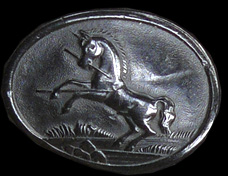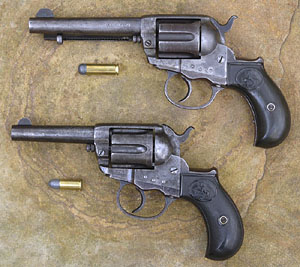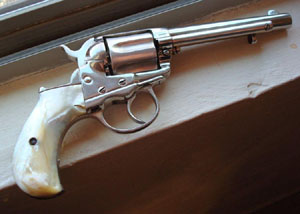 |
|||||||||||||||||||||||||||||||||||||||||||||||||
|
The 1877 Colt Double Action Revolver
The Colt’s Patent Fire Arms Manufacturing Company responded as quickly as it could, under the circumstances. The Model 1877 D.A. was Colt’s first foray into the field of double action pistols, and appeared three years before Smith & Wesson produced their first double action gun. Originally called the New Double Action Self-Cocking Central Fire Six Shot Revolver, the Model 1877 was designed by their well-known employee, William Mason*, who also designed the famed Single Action Army Model of 1873.
The 1877 D.A. was initially produced in .38 Colt (long or short), followed by the .41 Colt, and later still a few were made in .32 Colt (these are scarce). The .38 eventually became known by the trade name “Lightning” because of its rapid fire capability, and the .41 was called the “Thunderer.” The .32 was known as the “Rainmaker.” The guns were all identical externally, but had different barrel and cylinder bores. The ejectorless model was offered in five barrel lengths from 2 inches to 6 inches. The ejector model was offered in five barrel lengths, from 4½ inches to 7½ inches, but the 7 and 7½ inch barrels were special order only. A very few of the long-barreled guns were made with a flat top frame and target sights, most in .32 caliber according to Elmer Keith. Ejectorless models were fitted with a cylinder pin with a long head (missing in the gun shown here), since the pin was used to eject spent cases from the cylinder and had to come out often. The original grips on early guns are one-piece checkered rosewood, but the vast majority of later guns have two-piece hardened rubber (gutta-percha) grips with the rampant colt in an oval at the top. One- and two-piece ivory and pearl grips were available as upgrades. A very few one-piece hardened rubber grips were made--these are quite rare. The one-piece grips can only be installed or uninstalled by removing the grip-strap from the frame. Finishes were blue or nickel. The gun was made from 1877 to 1912.
John Wesley Hardin was carrying a .38 Colt Lightning revolver with a 2 inch barrel the day he was killed. A .41 Colt D.A. was later found in his room. Pat Garret owned an engraved .41 Colt D.A. William H. Bonney (Billy the Kid) is said to have carried two .41 caliber Colt double action pistols, and to have been in possession of at least one when he died. George Layman believes it to have been a Webley Bulldog, but I am very doubtful. * “William Mason was another of those who helped make the Colt Armory what it was. He was a modest, kindly man, little known outside of his immediate associates, but of a singular fertility in invention and almost unerring mechanical judgment. He learned his trade with the Remington Arms Company at Ilion, N.Y., and after a long association with them he was for sixteen years superintendent of the Colt Armory. In 1885 he became master mechanic of the Winchester Repeating Arms Company of New Haven, and held that position until his death in 1913. He had granted to him more than 125 patents, most of them in connection with arms and ammunition and tools for their manufacture, but they included many appliances for looms and weaving, steam pumps, and bridge work, and he assisted with the development of the Knowles steam pump and Knowles Looms.” From English and American Tool Builders, by Joseph Wickham Roe, Yale University Press, New Haven: 1916. Pp. 173-174. |
|||||||||||||||||||||||||||||||||||||||||||||||||
|
Copyright 2008-2014 by Ed Buffaloe. All rights reserved. |
|||||||||||||||||||||||||||||||||||||||||||||||||
|
|||||||||||||||||||||||||||||||||||||||||||||||||
|
|
|||||||||||||||||||||||||||||||||||||||||||||||||

 The Model 1877 Colt is similar in many respects to its single
action predecessor. Unfortunately, the one important respect in which it differs from the SAA is its reliability--the 1877 D.A. is notorious for mechanical problems, particularly as the gun ages and
parts get worn. Most gunsmiths today will not work on them. David R. Chicoine says of them, “The internal mechanism Colt used in these is overly intricate, many of its critical components are
as likely as not to break and these will often do so as frequently as the revolver’s action is operated, and that includes non-firing use.”
In a letter to me he stated “they just aren't worth the amount of hand labor it takes to make them work right again.” He does not recommend shooting a collectable 1877 Model Colt.
The Model 1877 Colt is similar in many respects to its single
action predecessor. Unfortunately, the one important respect in which it differs from the SAA is its reliability--the 1877 D.A. is notorious for mechanical problems, particularly as the gun ages and
parts get worn. Most gunsmiths today will not work on them. David R. Chicoine says of them, “The internal mechanism Colt used in these is overly intricate, many of its critical components are
as likely as not to break and these will often do so as frequently as the revolver’s action is operated, and that includes non-firing use.”
In a letter to me he stated “they just aren't worth the amount of hand labor it takes to make them work right again.” He does not recommend shooting a collectable 1877 Model Colt.
